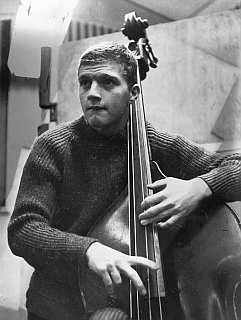Scott LaFaro facts for kids
Quick facts for kids
Scott LaFaro
|
|
|---|---|

LaFaro in 1958
|
|
| Background information | |
| Birth name | Rocco Scott LaFaro |
| Born | April 3, 1936 Newark, New Jersey, U.S. |
| Died | July 6, 1961 (aged 25) Seneca, New York, U.S. |
| Genres | |
| Occupation(s) | Musician |
| Instruments | Double bass |
| Years active | 1955–1961 |
| Labels |
|
Rocco Scott LaFaro (born April 3, 1936 – died July 6, 1961) was an American jazz musician. He was famous for playing the double bass. Scott LaFaro is best known for his work with the Bill Evans Trio.
LaFaro changed how the bass was played in jazz. Instead of just playing a steady beat, he played melodies that went along with the main tune. This was called a "countermelodic" style. He was also incredibly skilled, more than almost anyone else at the time. Even though he had a short career and passed away at 25, he is still one of the most important jazz bassists ever. Bass Player magazine ranked him among the top 100 bass players of all time.
By the way, the "Far" in LaFaro's last name sounds like "fair," not "far."
Contents
Early Life and Musical Start
Scott LaFaro was born in Newark, New Jersey. His father was also a musician in a big band. When Scott was five, his family moved to Geneva, New York.
He started playing music early. He played piano in elementary school and bass clarinet in middle school. In high school, he played the tenor saxophone. At 18, he began playing the double bass. He needed to learn a string instrument for his music education studies in college. After three months at Ithaca College, he decided to focus only on the bass. He played in local groups while in college.
Scott LaFaro's Career
In 1955, LaFaro joined the Buddy Morrow big band. Later, he moved to Los Angeles to work on his music. He spent many hours practicing his instrument. He even practiced sheet music written for the clarinet. This helped him play higher notes on the bass more easily. Another bassist, Red Mitchell, taught him how to pluck the strings with two fingers at once. For much of 1958, LaFaro played with pianist and vibraphonist Victor Feldman's band.
In 1959, LaFaro moved back east. He had played with famous musicians like Chet Baker and Benny Goodman. He then joined Bill Evans, who had just left the Miles Davis Sextet. With Evans and drummer Paul Motian, LaFaro developed his unique counter-melodic style. This trio believed that all three instruments should be equally important. They worked together to create one musical idea, often without one person strictly keeping the beat.
By late 1960, many musicians wanted LaFaro to play with them. He joined Ornette Coleman's band in early 1961. He also played with Stan Getz's band. Around this time, Miles Davis even sent him a card, hinting that he wanted to hire LaFaro.
In June 1961, the Bill Evans trio played for two weeks at the Village Vanguard in New York City. Their special style of playing got a lot of attention. Their last day of performances was recorded. These recordings became two famous albums: Sunday at the Village Vanguard and Waltz for Debby.
His Passing
Scott LaFaro passed away in a car accident on July 6, 1961. This happened in Seneca, New York, on U.S. Route 20. He was only 25 years old. The accident happened just four days after he played with Stan Getz at the Newport Jazz Festival.
Paul Motian, the trio's drummer, said that Bill Evans was very sad after LaFaro's death. Evans was deeply affected and stopped performing for several months. He often played "I Loves You, Porgy," a song that reminded him of LaFaro.
Bill Evans said that LaFaro was "one of the most, if not the most outstanding talents in jazz." Famous bassist Ray Brown also said LaFaro was incredibly talented for his age.
Scott LaFaro's Instruments
Scott LaFaro started his career playing a German-made double bass. This bass was stolen in 1958. Soon after, he got a bass made in 1825 by Abraham Prescott. This bass was special. It had a top made of three pieces of fir wood. The back was made of two pieces of maple wood.
The bass had rounded corners at the bottom and sloped shoulders at the top. This made it easier for LaFaro to play in a special way called "thumb position." He played this Prescott bass until he passed away. The bass was badly damaged in the car accident. However, it was later fixed. Sometimes, musicians still play it to honor LaFaro.
Bill Evans said LaFaro's Prescott bass had a "marvelous sustaining and resonating quality." He remembered LaFaro playing a chord and the sound lasting for a very long time. In 2008, another bassist, Marc Johnson, played LaFaro's bass on an album. This album honored Bill Evans.
Music Released After His Death
In 1988, an album called Memories for Scotty was released in Japan. It included five songs LaFaro recorded in 1961 with pianist Don Friedman and drummer Pete LaRoca.
In 2009, Resonance Records re-released these five songs on an album called Pieces of Jade. This album also included a 22-minute recording of LaFaro and Bill Evans practicing "My Foolish Heart" in 1960. Also in 2009, Scott's sister, Helene LaFaro-Fernandez, wrote a book about him called Jade Visions.
Honors and Legacy
On March 5, 2014, the city council in Geneva, New York, decided to make April 3 "Scott LaFaro Day." The next day, a street in downtown Geneva was renamed Scott LaFaro Drive.
Music expert Joachim Berendt said that LaFaro's new way of playing the bass "emancipated" the instrument. He showed that the bass could do many more things than people thought possible before.

